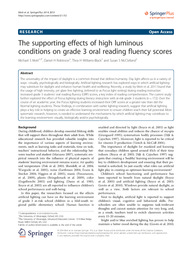| dc.contributor.author | Mott, Michael S. | |
| dc.contributor.author | Robinson, Daniel H | |
| dc.contributor.author | Williams-Black, Thea H | |
| dc.contributor.author | McClelland, Susan S | |
| dc.date.accessioned | 2017-08-28T19:59:56Z | |
| dc.date.available | 2017-08-28T19:59:56Z | |
| dc.date.issued | 2014 | |
| dc.identifier.citation | Published in SpringerPlus 3(53): 1-5, 2014 | en_US |
| dc.identifier.uri | http://hdl.handle.net/10106/26888 | |
| dc.description.abstract | The universality of the impact of daylight is a common thread that defines humanity. Day light affects us in a variety of
ways –visually, psychologically and biologically. Artificial lighting research has explored ways in which artificial lighting
may substitute for daylight and enhance human health and wellbeing. Recently, a study by Mott et al. 2011 found that
the usage of high intensity, yet glare free lighting, (referred to as Focus light setting) during reading instruction
increased grade 3 students’ oral reading fluency (ORF) scores, a key index of reading comprehension. The current study
further explored the effect of Focus lighting during literacy instruction with at-risk grade 3 students (n = 172). Over the
course of an academic year, the Focus lighting students increased their ORF scores at a greater rate than did the
Normal lighting students. These findings, in combination with earlier lighting research, suggest that artificial lighting
plays a key role in helping to create an effective learning environment to ensure children reach their full potential. More
systematic research, however, is needed to understand the mechanisms by which artificial lighting may contribute to
the learning environment: visually, biologically and/or psychologically. | en_US |
| dc.language.iso | en_US | en_US |
| dc.publisher | SpringerPlus | en_US |
| dc.rights | Attribution 2.0 United States | * |
| dc.rights.uri | This is an Open Access article distributed under the terms of the Creative Commons
Attribution License (http://creativecommons.org/licenses/by/2.0), which permits unrestricted use, distribution, and reproduction
in any medium, provided the original work is properly cited. | * |
| dc.subject | Daylight | en_US |
| dc.subject | Artificial lighting | en_US |
| dc.subject | Learning environment | en_US |
| dc.subject | Human health | en_US |
| dc.title | The supporting effects of high luminous conditions on grade 3 oral reading fluency scores | en_US |
| dc.type | Article | en_US |
| dc.publisher.department | Department of Curriculum and Instruction, The University of Texas at Arlington | en_US |
| dc.identifier.externalLinkDescription | The original publication is available at Article DOI | en_US |
| dc.identifier.doi | doi:10.1186/2193-1801-3-53 | |


